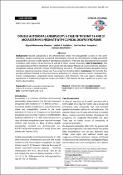Options
Double Autosomal Aneuploidy: A Case of Trisomy 18 and 21 Mosaicism in A Neonate with Clinical Down Syndrome
Journal
Malaysian Journal of Paediatrics and Child Health
ISSN
1511-4511
Date Issued
2024
Author(s)
Adilah W. Ab Rahim
Universiti Sains Islam Malaysia
Lim Yee Shan
Foong Eva
Halimah Abdul Halim
DOI
10.51407/mjpch.v30i1.273
Abstract
Background: Double aneuploidy is the phenomenon where two aneuploidies co-exist in the same individual, usually involving one autosomal chromosome and one sex chromosome. Double autosomal aneuploidy is rare and usually results in spontaneous abortions. There are only six published case reports of liveborn with trisomy 18 and trisomy 21 and all of which involve mosaicism. Case Presentation: This case report documents an infant born at 35 weeks with phenotypic features of Down Syndrome. However, cytogenetic analysis showed a mosaic of both trisomy 18 and 21. The patient initially had patent ductus arteriosus requiring operative closure and has congenital hypothyroidism. Conclusion: We describe five possible pathways leading to this phenomenon, including error during meiosis, meiotic nondisjunction, mitotic nondisjunction, sequential mitotic segregation and chimerism. This case report reiterates the significance of traditional cytogenetic analysis in children with features of Down Syndrome to detect any further abnormalities.
File(s)
Loading...
Name
Double Autosomal Aneuploidy A Case Of Trisomy 18 And 21 Mosaicism In A Neonate With Clinical Down Syndrome.pdf
Type
main article
Size
627.41 KB
Format
Adobe PDF
Checksum
(MD5):8bd33c436cadf9340af8b36b2cba9a3a